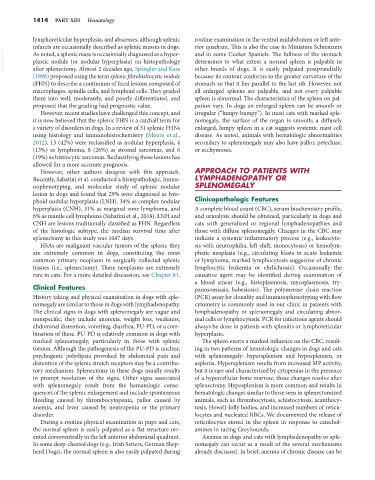Page 1442 - Small Animal Internal Medicine, 6th Edition
P. 1442
1414 PART XIII Hematology
lymphoreticular hyperplasia, and abscesses, although splenic routine examination in the ventral midabdomen or left ante-
infarcts are occasionally described as splenic masses in dogs. rior quadrant. This is also the case in Miniature Schnauzers
VetBooks.ir As noted, a splenic mass is occasionally diagnosed as a hyper- and in some Cocker Spaniels. The fullness of the stomach
determines to what extent a normal spleen is palpable in
plastic nodule (or nodular hyperplasia) on histopathology
after splenectomy. Almost 2 decades ago, Spangler and Kass
because its contour conforms to the greater curvature of the
(1998) proposed using the term splenic fibrohistiocytic nodule other breeds of dogs. It is easily palpated postprandially
(FHN) to describe a continuum of focal lesions composed of stomach so that it lies parallel to the last rib. However, not
macrophages, spindle cells, and lymphoid cells. They graded all enlarged spleens are palpable, and not every palpable
them into well, moderately, and poorly differentiated, and spleen is abnormal. The characteristics of the spleen on pal-
proposed that the grading had prognostic value. pation vary. In dogs an enlarged spleen can be smooth or
However, recent studies have challenged this concept, and irregular (“lumpy-bumpy”). In most cats with marked sple-
it is now believed that the splenic FHN is a catchall term for nomegaly, the surface of the organ is smooth; a diffusely
a variety of disorders in dogs. In a review of 31 splenic FHNs enlarged, lumpy spleen in a cat suggests systemic mast cell
using histology and immunohistochemistry (Moore et al., disease. As noted, animals with hematologic abnormalities
2012), 13 (42%) were reclassified as nodular hyperplasia, 4 secondary to splenomegaly may also have pallor, petechiae,
(13%) as lymphoma, 8 (26%) as stromal sarcomas, and 6 or ecchymoses.
(19%) as histiocytic sarcomas. Reclassifying these lesions has
allowed for a more accurate prognosis.
However, other authors disagree with this approach. APPROACH TO PATIENTS WITH
Recently, Sabatini et al. conducted a histopathologic, immu- LYMPHADENOPATHY OR
nophenotyping, and molecular study of splenic nodular SPLENOMEGALY
lesion in dogs and found that 29% were diagnosed as lym-
phoid nodular hyperplasia (LNH), 34% as complex nodular Clinicopathologic Features
hyperplasia (CNH), 31% as marginal zone lymphoma, and A complete blood count (CBC), serum biochemistry profile,
6% as mantle cell lymphoma (Sabatini et al., 2018). LNH and and urinalysis should be obtained, particularly in dogs and
CNH are lesions traditionally classified as FHN. Regardless cats with generalized or regional lymphadenopathies and
of the histologic subtype, the median survival time after those with diffuse splenomegaly. Changes in the CBC may
splenectomy in this study was 1087 days. indicate a systemic inflammatory process (e.g., leukocyto-
HSAs are malignant vascular tumors of the spleen; they sis with neutrophilia, left shift, monocytosis) or hemolym-
are extremely common in dogs, constituting the most phatic neoplasia (e.g., circulating blasts in acute leukemia
common primary neoplasm in surgically collected splenic or lymphoma, marked lymphocytosis suggestive of chronic
tissues (i.e., splenectomy). These neoplasms are extremely lymphocytic leukemia or ehrlichiosis). Occasionally the
rare in cats. For a more detailed discussion, see Chapter 81. causative agent may be identified during examination of
a blood smear (e.g., histoplasmosis, mycoplasmosis, try-
Clinical Features panosomiasis, babesiosis). The polymerase chain reaction
History taking and physical examination in dogs with sple- (PCR) assay for clonality and immunophenotyping with flow
nomegaly are similar to those in dogs with lymphadenopathy. cytometry is commonly used in our clinic in patients with
The clinical signs in dogs with splenomegaly are vague and lymphadenopathy or splenomegaly and circulating abnor-
nonspecific; they include anorexia, weight loss, weakness, mal cells or lymphocytosis. PCR for infectious agents should
abdominal distention, vomiting, diarrhea, PU-PD, or a com- always be done in patients with splenitis or lymphoreticular
bination of these. PU-PD is relatively common in dogs with hyperplasia.
marked splenomegaly, particularly in those with splenic The spleen exerts a marked influence on the CBC, result-
torsion. Although the pathogenesis of the PU-PD is unclear, ing in two patterns of hematologic changes in dogs and cats
psychogenic polydipsia provoked by abdominal pain and with splenomegaly: hypersplenism and hyposplenism, or
distention of the splenic stretch receptors may be a contribu- asplenia. Hypersplenism results from increased MP activity,
tory mechanism. Splenectomy in these dogs usually results but it is rare and characterized by cytopenias in the presence
in prompt resolution of the signs. Other signs associated of a hypercellular bone marrow; these changes resolve after
with splenomegaly result from the hematologic conse- splenectomy. Hyposplenism is more common and results in
quences of the splenic enlargement and include spontaneous hematologic changes similar to those seen in splenectomized
bleeding caused by thrombocytopenia, pallor caused by animals, such as thrombocytosis, schistocytosis, acanthocy-
anemia, and fever caused by neutropenia or the primary tosis, Howell-Jolly bodies, and increased numbers of reticu-
disorder. locytes and nucleated RBCs. We documented the release of
During a routine physical examination in pups and cats, reticulocytes stored in the spleen in response to catechol-
the normal spleen is easily palpated as a flat structure ori- amines in racing Greyhounds.
ented dorsoventrally in the left anterior abdominal quadrant. Anemia in dogs and cats with lymphadenopathy or sple-
In some deep-chested dogs (e.g., Irish Setters, German Shep- nomegaly can occur as a result of the several mechanisms
herd Dogs), the normal spleen is also easily palpated during already discussed. In brief, anemia of chronic disease can be

